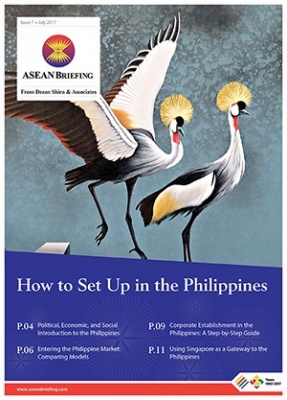
How to Set Up in the Philippines
Published: July 2017In this issue of ASEAN Briefing magazine, we provide an introduction to the Philippines as well as analyze the various market entry options available for investors interested in expanding to the island nation. We also discuss the step-by-step process for setting up a business entity in the Philippines, highlighting the various statutory requirements for overseas investors. Finally, we explore the potential for Singapore to serve as a viable base to administer investors’ Philippine operations.
No. of Pages: 12 pages
In this issue:
- Political, Economic, and Social Introduction to the Philippines
- Entering the Philippine Market: Comparing Models
- Corporate Establishment in the Philippines: A Step-by-Step Guide
- Using Singapore as a Gateway to the Philippines
Within ASEAN, the Philippines has proved to be the least vulnerable country to external economic shocks. Sound macroeconomic fundamentals, a steady economic growth rate, and a steadfast commitment to good governance by successive governments in the last decade offer foreign investors a stable base to consolidate their ASEAN operations.
The Philippines has an abundance of SEZs spread throughout the country, which have unique investment incentives. The country has a growing supply of trained and skilled labor as well as semi-skilled workers. The Philippines also has a language edge over some other ASEAN countries, as most Filipino workers are well-versed in English.
Further, successive governments have recognized that corruption and inadequate infrastructure are two of the key limiters of sustained economic gains, and have taken measures to initiate tax reform and reduce bureaucratic red tape. The current government’s planned tax reform package and the anticipated corporate income tax (CIT) rate cut is likely to attract more foreign investment.
In this issue of ASEAN Briefing magazine, we provide an introduction to the Philippines as well as analyze the various market entry options available for investors interested in expanding to the island nation. We also discuss the step-by-step process for setting up a business entity in the Philippines, highlighting the various statutory requirements for overseas investors. Finally, we explore the potential for Singapore to serve as a viable base to administer investors’ Philippine operations.

